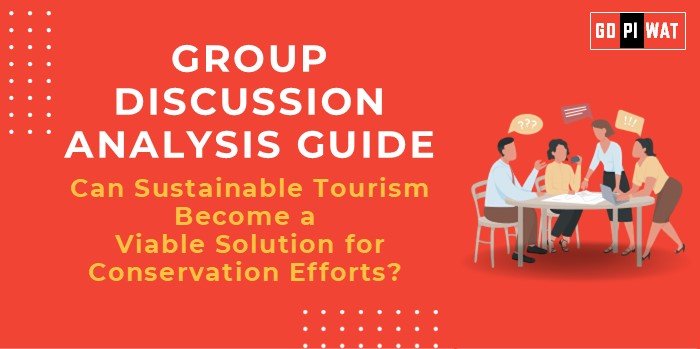📋 Group Discussion (GD) Analysis Guide: Can Sustainable Tourism Become a Viable Solution for Conservation Efforts?
🌐 Introduction to Sustainable Tourism
- Opening Context: Sustainable tourism blends the economic benefits of tourism with the imperative to conserve environmental and cultural heritage. Its growing relevance is evident as global environmental challenges escalate.
- Topic Background: The concept emerged in the late 20th century as a response to overtourism and environmental degradation. The United Nations declared 2017 the “Year of Sustainable Tourism for Development,” emphasizing its global importance.
- Recent Updates: In 2023, UNESCO and UNWTO reported a 25% rise in eco-friendly tourism initiatives worldwide, underlining its increasing adoption.
📊 Quick Facts and Key Statistics
- 🏞️ Tourism GDP Contribution: 10% of global GDP – reflects the sector’s economic significance.
- 🌳 Biodiversity Impact: 40% of global biodiversity is located in ecotourism zones – showcases the potential for conservation.
- 🌍 Overtourism Stats: Venice receives 30 million tourists annually – highlights challenges of unsustainable tourism.
- 📈 Eco-tourist Growth: 20% CAGR in eco-tourism market post-2020 – indicates a growing shift towards sustainability.
🤝 Stakeholders and Their Roles
- Governments: Policy framing, regulation, and funding conservation projects.
- Private Sector: Promoting eco-tourism services, managing sustainable travel experiences.
- Local Communities: Custodians of cultural heritage and biodiversity, benefiting economically.
- NGOs and International Bodies: Advocating for best practices and supporting implementation.
🏆 Achievements and Challenges
✨ Achievements
- 🌱 Costa Rica’s Model: $4 billion from sustainable tourism, contributing to 52% forest cover.
- 🌍 UNESCO World Heritage Initiatives: Boosted conservation funding by 30% globally.
- 👨👩👧👦 Community Empowerment in Bhutan: 65% of tourism revenue benefits locals.
⚠️ Challenges
- 🌴 Overdependence on tourism: Fragile ecosystems like the Galápagos Islands face strain.
- ✈️ Rising Carbon Footprints: Emissions from international travel undermine sustainability.
- 💸 Inadequate Funding: Local conservation efforts often lack sufficient resources.
Global Comparisons:
- 🇳🇿 Success: New Zealand integrates Māori culture in eco-tourism.
- 🇹🇭 Struggles: Thailand’s beaches face closure due to environmental degradation.
Case Study: Kaziranga National Park, India: Eco-tourism helped double the rhino population in a decade.
📖 Structured Arguments for Discussion
- ✅ Supporting Stance: “Sustainable tourism ensures economic growth while preserving natural ecosystems.”
- ⚡ Opposing Stance: “Despite its potential, sustainable tourism often leads to greenwashing and unchecked carbon emissions.”
- ⚖️ Balanced Perspective: “Sustainable tourism, while promising, requires robust policy and community engagement to succeed.”
💡 Effective Discussion Approaches
📣 Opening Approaches
- 🌍 Begin with global statistics on biodiversity loss.
- 📜 Use a compelling case study like Costa Rica’s eco-tourism success.
🛡️ Counter-Argument Handling
- 🌟 Acknowledge challenges like greenwashing but emphasize potential solutions such as carbon offsets and community engagement.
🛠️ Strategic Analysis of Strengths and Weaknesses
- Strengths: Economic upliftment, biodiversity preservation, cultural revival.
- Weaknesses: High initial costs, risk of greenwashing.
- Opportunities: Innovation in eco-tourism technologies, public-private partnerships.
- Threats: Overtourism and ecosystem exploitation.
🔗 Connecting with B-School Applications
- Real-World Applications: Projects on sustainable business models for tourism.
- Sample Interview Questions:
- “How can sustainable tourism address global conservation challenges?”
- “Discuss the role of technology in promoting eco-tourism.”
- Insights for Students:
- Understanding the economics of conservation.
- Learning from global best practices for sustainable tourism.


